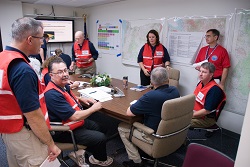Defining “At-Risk” Populations
 When asked to define which population groups are included under the “at-risk population” umbrella in a jurisdiction, the answers could vary greatly from person to person. There are a wide variety of public health preparedness planning considerations that need to be met to ensure specific at-risk groups get access to emergency information and interventions. Though the term “at-risk population” may vary from organization to organization, it is important that preparedness planners determine a working definition as there are specific requirements that speak to addressing the needs of these individuals in a variety of CDC guidance documents including the CDC Public Health Preparedness Capabilities, Medical Countermeasure Operational Readiness Review (MCM ORR), and the CDC Public Health Workbook: To Define, Locate, and Reach Special, Vulnerable, and At-risk Populations in an Emergency [1].
When asked to define which population groups are included under the “at-risk population” umbrella in a jurisdiction, the answers could vary greatly from person to person. There are a wide variety of public health preparedness planning considerations that need to be met to ensure specific at-risk groups get access to emergency information and interventions. Though the term “at-risk population” may vary from organization to organization, it is important that preparedness planners determine a working definition as there are specific requirements that speak to addressing the needs of these individuals in a variety of CDC guidance documents including the CDC Public Health Preparedness Capabilities, Medical Countermeasure Operational Readiness Review (MCM ORR), and the CDC Public Health Workbook: To Define, Locate, and Reach Special, Vulnerable, and At-risk Populations in an Emergency [1].
The CDC suggests that health departments begin to define, locate, and reach at-risk populations based on five major categories including economic disadvantage, language and literacy competency, medical issues and disability, isolation (including cultural, geographic, or social), and age; though the factors of any particular emergency may create new at-risk individuals that may not have otherwise been categorized into one of those grouping(s) initially [2].
Determining an Inclusion Strategy for MCM Planning
Beyond just addressing the definition of at-risk populations, preparedness planners must develop strategies to determine specific needs of their entire communities, identify and quantify those needs, and acquire and develop resources that address them. In regards to MCM planning, jurisdictions must ensure that point of dispensing (POD) locations are accessible (e.g. ADA compliant, near public transportation, etc.), response plans include the use of specialized staff (e.g. interpreters, behavioral health professionals, etc.), public information is available in a variety of formats and languages, a variety of MCM interventions are available when possible (pediatric formulations, medications for those with allergies, different sizes of medical equipment, etc.) and on-site and electronic resources address those with specific access needs (e.g. specialized signage, translated materials, large-print materials, etc.) [3]
In addition, in order to build comprehensive preparedness plans that are inclusive of at-risk populations, preparedness planners must take a “whole-community” approach towards engaging a diverse range of community partners. Community partners (e.g. non-profit organizations serving people with disabilities, homeless shelters, faith-based organizations, etc.) can help bridge the gap between local health departments and the individuals that those organizations serve. Including individuals with functional and access needs in their planning meetings and exercises often can help health departments identify planning shortfalls with respect to certain populations. Developing strategies to address those gaps in advance of an emergency will help to reduce the negative health impacts on those populations and ensure that the needs of the whole community will be met during an emergency.
Local Health Department Perspectives on At-Risk Populations
In July, NACCHO released a two-part podcast series featuring panels of local health department preparedness representatives that described how they identify and plan for populations with functional and access needs in their jurisdictions. Panelists discussed strategies for inclusive preparedness planning highlighting some specifics as it relates to their MCM planning efforts.
Using Community Partners to Address the Needs of At-Risk Populations for Medical Countermeasure Planning and Response (July, 2015). Speakers:
- Sarah Babcock, New Orleans Health Department, LA
- Elizabeth Rowell, Robeson County Department of Public Health, NC
- Nicholas Scarborough, Southeastern Idaho Public Health, ID
Defining and Identifying At-Risk Populations for Medical Countermeasure Planning and Response (July, 2015). Speakers:
- Chad Thomas, Philadelphia Department of Public Health, PA
- Karla Black, Kent County Health Department, MI
- Rhonda D’Amico, Southeastern Idaho Public Health, ID
Additional NACCHO Resources Available
In addition to the perspectives and strategies offered on the podcasts above, NACCHO has additional resources on inclusive preparedness planning and partnering with community organizations:
- Improved Planning for Vulnerable Populations through Use of Closed PODs
- Whole Community Inclusion Project (contains strategies for building inclusive POD operational plans)
- Inclusive Just-in-Time Training for Mass Prophylaxis/POD Operations
- NACCHO’s Health and Disability webpage (includes a variety of related to emergency planning and community partnerships)
[1] Sheldrew, D. (2010). Defining “At Risk” Populations. Minnesota Department of Health. Retrieved August 18, 2015 from http://www.health.state.mn.us/oep/responsesystems/atriskdef.pdf
[2] Centers for Disease Control and Prevention, CDC Public Health Workbook: To Define, Locate, and Reach Special, Vulnerable, and At-risk Populations in an Emergency. Retrieved August 18, 2015 from http://www.bt.cdc.gov/workbook/pdf/ph_workbookFINAL.pdf
[3] Grimm, D. (2015) Ensuring Equal Access to POD Services for Disability Populations and Others with Access and Functional Needs. Presented at the 2015 Texas MCM Symposium. Retrieved August 18, 2015 from https://txmcmsymposium.com/Documents/Ensuring%20Equal%20Access%20to%20POD%20Services%20for%20Disability%20Populations.pptx.pdf








